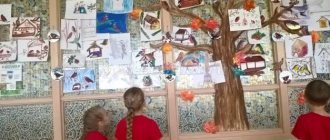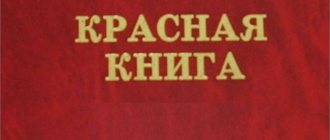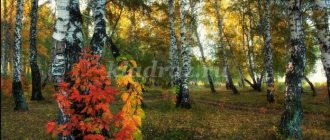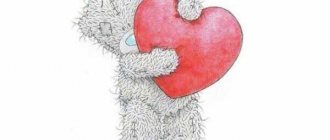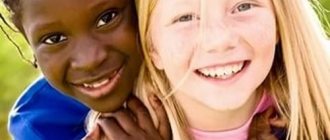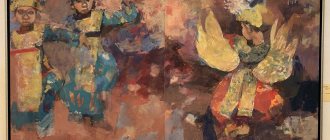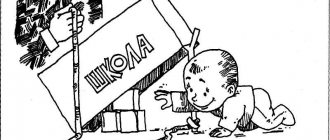Extracurricular event for elementary school with a presentation for Pet Day
Event for junior schoolchildren on Pet Day “We are responsible for those we have domesticated”
Author : Malevannaya Natalya Nikolaevna Description: The scenario of this event can be useful for additional education teachers, as well as primary school teachers. Goal: to develop a caring attitude towards pets, responsibility for their maintenance and an understanding that they are “our little brothers” and not an object of entertainment. Objectives: Educational : - give an idea of the origin of the holiday “Pet Protection Day”; — introduce different breeds of cats and dogs Developmental: — develop children’s cognitive activity. - develop speech and thinking. Educational: - to cultivate humane universal qualities - care, compassion; — cultivate a sense of responsibility for tamed animals; Equipment: laptop, tokens in the form of bones and fish, pictures with different breeds of dogs and cats, coloring books with different breeds of dogs and cats, colored pencils or markers, two pictures (with a puppy and with a cat), cut into the same number of pieces - "puzzles". Preliminary preparation: children are divided into 2 teams, choose the name “Cats” or “Dogs”.
Progress of the event:
1. Information about Pet Protection Day. Show presentation. First slide. Teacher: Hello, guys! The motto of our today's event: “We are responsible for those we have tamed.” This phrase was said by the great French writer Antoine de Saint-Exupéry. How do you understand this phrase?
Second slide. Every year on November 30, many countries celebrate World Pet Day. The idea of establishing this holiday was voiced at the International Congress of supporters of the movement for the protection of nature, held in Florence (Italy) in 1931. In many countries, events are held on this day to protect domestic animals. Remember the words of Saint-Exupery: “We are responsible for those we have tamed.” They should have the right to a good life. The holiday is dedicated to all animals domesticated by humans in order to once again remind all humanity of the responsibility for “our little brothers.”
Third slide. In Russia, Pet Day has been celebrated since 2000 on the initiative of the International Fund for Animal Welfare, although, unfortunately, it has not yet been officially approved.
Fourth slide. —Have you ever thought about why a person gets a cat, a dog, a parrot, fish or other pets in his house? Fifth slide. 1. Pets are our good friends. 2. Pets are our healers. 3. Pets are our helpers and protectors. 4. They give us joy and happiness.
Sixth slide. People who have pets live longer than those who don't. This is a research result that has been practically confirmed. Thus, animal-assisted treatments are officially approved in many countries. Pets that help sick people are dogs, cats, horses. Seventh slide. There are children, a disease when a person’s arms and legs cannot move well and every movement is difficult and painful. This disease also occurs in children. Such children usually spend their lives in a wheelchair. Now there is a technique to alleviate the course of such diseases. Special lessons are conducted under the guidance of experienced specialists - dog handlers, during which children communicate with dogs - play with them, pet them. First of all, it is important that the guys get positive emotions from communicating with dogs. After all, it doesn’t matter to a dog whether the person next to her is sick or healthy, handsome or ugly, she is happy with everyone and is obedient with everyone. Next to them, children become full-fledged people and for the first time in their lives they feel like masters of the situation. In addition, by playing with the animal, riding it, hugging it, simply stroking its fur, the child adopts the movements of the dog’s muscles and his paralyzed muscles begin to develop. Thus, positive emotions are accompanied by additional physical activity. A common exercise is the “fetch” command: the child throws a ball and the dog must fetch it.
Eighth slide. Canistherapy
is treatment involving dogs. It is carried out with the participation of specially trained dogs. Tail doctors will help with: physical inactivity associated with a sedentary lifestyle, insomnia, autism, nervous tension, relieves arrhythmia, dog saliva heals wounds. Products made from dog hair help relieve joint pain, back pain, arthritis and arthrosis.
Ninth slide. Felinotherapy
is a treatment involving cats. The purring of a cat has a calming effect on the psyche of patients who have undergone treatment. Cats treat: Heart disease, hypertension. The purring and claws of the needle have a beneficial effect on fractures and reduce joint pain. Activate the immune system, relieve stress and fatigue, and save from loneliness.
Tenth slide. Hippotherapy
is treatment involving horses. Recently, horses have been used to treat cerebral palsy and childhood autism. Horses also help with mental development and speech disorders in children.
Eleventh slide. There is still a small monastery in the Alps called Saint Bernard. In it, monks once upon a time bred a breed of dogs that became the ancestors of the modern St. Bernard. Huge dogs were trained to rescue travelers lost in the mountains and victims of avalanches. The monks noticed that the dogs sensed a person during a storm 300-400 meters away, at a depth of 2 meters or more under the snow, and also had an excellent sense of avalanches. These dogs can stay in extreme cold for hours and diligently perform their difficult work. A traveler in cold conditions is overcome by fatigue and drowsiness. Dogs dug people out from under the snow and warmed them with their bodies. And when the storm subsided and the avalanche disappeared, the monks went out into the mountains to help their pets and people and delivered them to the monastery. This is how animals helped save those in trouble.
Twelfth slide. — These are dogs of the St. Bernard breed.
Thirteenth slide. St. Bernard Barry brought glory to the monastery, saving more than 40 people. Every day he went in search of travelers who had gone astray, dug them out from under the snow, warmed them with the warmth of his body, and if he failed, he went to the monastery for help. Barry was erected a monument after his death.
Fourteenth slide. — Guys, look at these photographs and tell me how else dogs help people? Fifteenth slide. “But it’s not only dogs that help people. There are many cases where cats saved people. This monument is dedicated to the cat Panteleimon, who lived in a restaurant in Kyiv, located opposite the Golden Gate. Once there was a fire in a restaurant, the cat behaved unusually: he rushed around the room from table to table, screamed loudly, and grabbed visitors by the legs. People left the hall in bewilderment and only after they found themselves on the street did they notice that the restaurant was on fire. Pantyusha died. He suffocated in the smoke.
Sixteenth slide. People erect monuments to animals in gratitude. But it is much more important to save the life of a living creature than to erect a monument as an awareness of one’s guilt before it. There are people who throw animals into the street. And their life becomes painful. They have no food, warmth or affection. They have to live in basements and on the street. They get sick and die. You need to responsibly treat an animal that becomes a member of your family if you take it into your home.
Seventeenth slide. "Stray Cat" - One day I met a stray cat. - How are you doing? - Nothing, little by little. – I heard that you are seriously ill? - I was sick. - So, you were lying in bed? - Homeless... I have nowhere to put a bed... - How strange, - I thought, - That in this huge world there is no place for homeless dogs and cats. Do you hear, cat, come with me, It’s getting dark, and that means it’s time for us to go home! We walked with her down the street proudly and boldly - I was silent, and the cat sang softly. What was she singing about? Perhaps it’s about the fact that everyone needs their own home! (Alexey Dmitriev) - Guys, what is this poem about? Right! Everyone needs their own home! Even the cat!
Eighteenth slide. Stray animals. A sore point for many states and cities. There are also many stray dogs and cats in our city. What ways do you know to protect homeless animals? How should their fate be decided? After all, it is now clear to the entire civilized world that killing stray animals, first of all, is cruel. Let's guys think about what a dog and cat shelter is. These are clean and comfortable cages for animals, which should be provided with water and food, and warmth in the winter. The cages need to be cleaned, the animals must be examined and treated, they must be vaccinated against various diseases so that there are no epidemics. Animals need to be walked. Their shelter allows you to take an animal home. A purebred dog is expensive, but you can adopt a dog or cat for free at a shelter. At the shelter, one could learn to train a dog, listen to conversations on how to care for it. If parents are against keeping animals in the house, you could come and talk to the animal at the shelter.
Nineteenth slide. In our city and in many others there is an Animal Welfare Society. Community members do a lot of work to protect homeless animals and create shelter for them. There are many animal protection sites on the Internet. What if there are still no shelters, and you come across homeless animals on the street? What should I do? First of all, don't offend them. Don't be afraid, but also be careful. If you encounter a pack of barking, aggressive stray dogs, try to avoid it. If you pet a homeless animal, wash your hands.
Twenty slide. It’s good if you can figure out whether the animal is lost or has become accustomed to the street. If lost, it behaves insecurely, frightened, and seeks help from a person. If you can, help him. Write an ad or pay attention to ads about lost animals. Indicate the area where you saw the animal, the signs of the dog or cat - coat color, breed if you know.
Twenty-one slide. - And of course, guys, we must take care of those animals that live in our home. Feed, walk, wash, treat on time. — If the animal’s eyes are watery or there is pus in the corners of the eyes. The animal has diarrhea, vomiting or constipation. The animal lies down, reluctantly responds to the call, and limps. If your pet shows any signs of illness, contact your veterinarian as soon as possible.
Twenty-second slide. — Many diseases of dogs and cats are the same as those of humans. Dogs, for example, can get sunstroke if they are exposed to the sun for a long time in the heat. There are many cases where a dog was left for a long time in a closed car parked in the sun. This caused the death of the animal. If a dog walks for a long time on a hot day wearing a muzzle, it should be spacious so that the dog can breathe with its tongue out, since it does not have sweat glands, and breathing with its tongue out serves as protection against overheating of the animal.
Twenty-third slide. Pets need to be fed properly, walked, and the right place to rest - not in a draft, for example. And a bird in a cage cannot be kept near the stove in the kitchen.
Twenty-fourth slide. You need to be responsible for their content and understand that they are “our little brothers” and not an object of entertainment. I think you all understand that you cannot abuse animals. They feel pain, cold, hunger just like we humans do. You cannot cause even the slightest suffering to all living things. We condemn those heartless people who throw cats and dogs into the streets, dooming them to torture and even death. Guys, show concern for homeless animals, feed them, help them survive.
Twenty-fifth slide. - And at the end of the presentation, let's look at our favorites again and smile! 2. Game moment. 1. Riddles about pets. 1) She doesn’t speak, doesn’t sing, but whoever goes to the owner, she lets him know. (Dog) 2) Lives calmly, is in no hurry, and carries a shield just in case. Under it, without knowing fear, Walks... (turtle) 3) Mustachioed muzzle, Striped fur coat, Often washed, But not familiar with water. (cat) 4) She is carrying a cart. Eats hay and oats. (horse) 5) Small, gray, with a long tail. Runs for cheese, squeaks loudly. (mouse) 6) The tigress has a tiger cub, the goat has a kid, the cat has a kitten, the sheep? (lamb) 7) Red Dairy chews day and chews night: After all, grass is not so easy to turn into milk! (cow) Who has a snout that is not squeezed into a fist? His feet have hooves. He eats and drinks from a trough. (pig) 9) Long ear, ball of fluff, jumps deftly, loves carrots. (rabbit) 10) There is a cage hanging in the room, A miracle bird is sitting in it, It screams piercingly, It picks it up and speaks. Well, think about it, guess what kind of bird it is?...(parrot). 11) The red-haired little animal began to prepare food for future use: He cleverly arranged a pantry behind his cheek. (hamster) 12) We live in water, Without water we will be lost. (fish) 3. Game “Like who?” - Guys, every day we use different phrases in which we compare each other with different animals, implying that the person to whom we say this is somewhat similar to this animal, for example: hungry, like a wolf. In the second game, I will read the beginning of such phrases, and you will have to finish it by naming the animal that should be in this phrase. 1) Angry like... (dog) 2) Stubborn like... (ram) 3) Quiet like... (mouse) 4) Hardy like... (horse) 5) Puffy like... (turkey) 6) Dirty like... ... (pig) 3. Creative competition “Different breeds of dogs and cats.” Teacher: On the board we have pictures with different breeds of dogs and cats. I will now give you coloring drawings of different breeds of dogs and cats. Your task is to correctly color the picture you received. All members of each team participate in the competition. For each beautifully, neatly and correctly painted drawing, teams receive tokens. The team that earns the most tokens will win this competition. Different breeds of cats. Maine
(Dog) 2) Lives calmly, is in no hurry, and carries a shield just in case. Under it, without knowing fear, Walks... (turtle) 3) Mustachioed muzzle, Striped fur coat, Often washed, But not familiar with water. (cat) 4) She is carrying a cart. Eats hay and oats. (horse) 5) Small, gray, with a long tail. Runs for cheese, squeaks loudly. (mouse) 6) The tigress has a tiger cub, the goat has a kid, the cat has a kitten, the sheep? (lamb) 7) Red Dairy chews day and chews night: After all, grass is not so easy to turn into milk! (cow) Who has a snout that is not squeezed into a fist? His feet have hooves. He eats and drinks from a trough. (pig) 9) Long ear, ball of fluff, jumps deftly, loves carrots. (rabbit) 10) There is a cage hanging in the room, A miracle bird is sitting in it, It screams piercingly, It picks it up and speaks. Well, think about it, guess what kind of bird it is?...(parrot). 11) The red-haired little animal began to prepare food for future use: He cleverly arranged a pantry behind his cheek. (hamster) 12) We live in water, Without water we will be lost. (fish) 3. Game “Like who?” - Guys, every day we use different phrases in which we compare each other with different animals, implying that the person to whom we say this is somewhat similar to this animal, for example: hungry, like a wolf. In the second game, I will read the beginning of such phrases, and you will have to finish it by naming the animal that should be in this phrase. 1) Angry like... (dog) 2) Stubborn like... (ram) 3) Quiet like... (mouse) 4) Hardy like... (horse) 5) Puffy like... (turkey) 6) Dirty like... ... (pig) 3. Creative competition “Different breeds of dogs and cats.” Teacher: On the board we have pictures with different breeds of dogs and cats. I will now give you coloring drawings of different breeds of dogs and cats. Your task is to correctly color the picture you received. All members of each team participate in the competition. For each beautifully, neatly and correctly painted drawing, teams receive tokens. The team that earns the most tokens will win this competition. Different breeds of cats. Maine
Coon
Siamese
Sphinxes
Persian
Devon Rex
Singaporean
Bombay
Coloring pages for the competition - different breeds of cats. Coloring pages - different breeds of dogs. The pictures are different breeds of dogs. Boxer
Beagle
Doberman
Basset Hound
Bulldog
Laika
Cocker Spaniel
4. Game “Collect a picture”
Teacher: Guys, one person from each team participates in this game. The task is to complete the “puzzles” of your picture faster than your opponent. One person will collect a drawing of a cat, the other will collect a drawing of a puppy. The one who does it faster will win.
3. Summing up, awarding the winners.
Presentation for junior schoolchildren on Pet Day
We recommend watching:
Initiation into the Young People's Union. Scenario Scenario for a spring environmental holiday in elementary school Scenario for an environmental holiday in 2nd grade Ecological holiday. Scenario for 1st - 2nd grade
Similar articles:
Extracurricular lesson on ecology, grades 1-2
Summary of extracurricular activities on the topic of Nature conservation for primary schoolchildren
Extracurricular activity on nature conservation in primary school
Extracurricular activity “Pets”, grades 1-2
Summary of an extracurricular lesson for junior schoolchildren “Why were animals domesticated?”
Objectives : to introduce students to how the domestication of wild animals took place, to show the importance of domestic animals for humans. Objectives : to cultivate curiosity, a kind and responsible attitude towards animals, and a desire to help them. Let's start the lesson by reviewing the material covered. Let us remember what the concept of living nature includes. This is the flora and fauna. What groups are animals divided into? Animals, birds, fish, insects. What are the names of animals whose bodies are covered with scales? Fish. What are the names of animals whose bodies are covered with feathers? Birds. What are the names of animals whose bodies are covered with hair? Animals. Listen to the riddles. The owner of the yard, His house is a kennel. He wags his tail joyfully, But he won’t let a stranger into the house. Dog Gray, fat southern beast... Extra tail? Don't believe it! He chases flies with his ears, and draws water with his nose. Elephant Who knows how to wash himself without water - with his tongue? And meow, and caress, And chase the ball? The cat , the owner of the forest, wakes up in the spring, and in winter, to the howl of a blizzard, sleeps in a snowy hut. Bear He looks like a shepherd dog. Every tooth is a sharp knife! He runs, baring his mouth, ready to attack the sheep. The wolf eats grass, chews, is silent... And then for half a day he moos: - Stroke my sides - I’ll give you fresh milk! The cow jumps and frolics from branch to branch, agile, agile, and not a bird. Squirrel Who were they talking about in the riddles? (About animals) What 2 groups can these animals be divided into? (For wild and domestic ones). Has it always been this way: have both wild and domestic animals existed on Earth? Today we will talk about animals that were once tamed and domesticated by man. How do you explain this concept - domestication? This is the process of taming wild animals by humans and then breeding them for their own needs. It may be difficult for you to imagine that in those ancient times there were no cities and villages, airplanes and cars, computers and telephones on Earth. In a word, everything that surrounds us now did not exist. People lived in caves. To feed themselves and their children and make primitive clothing, they hunted. These were strong and courageous people, but they were also afraid of attacks from ferocious predators. And then the time came (about 10-15 thousand years ago) when people began to feed the wolves that walked in packs around their homes. Gradually, the wolves stopped showing aggression, and their puppies got used to people and began to live next to them. These were no longer wild animals, they became domesticated. Thus, the very first animal that man tamed was the dog, man’s faithful friend. She was a hunting assistant and guarded the home.
Returning from hunting wild boars, bulls, rams, goats, primitive people, along with their prey, brought home their offspring - piglets, calves, lambs, kids. So, these animals also became domestic animals. They were kept in special pens. Later, man tamed the wild horse, his faithful companion for thousands of years.
The domestication of animals went through many stages and took many generations. Domestic animals were already very different from their wild relatives in both appearance and character. They developed obedience and affection for people. They got used to the conditions created for them by man. Externally, large species have decreased in size, while small ones have increased in size and become shorter in length. There was a change in the properties of wool and feathers, color. Domestic animals have lost the qualities they needed to survive in the wild. Task 1. Connect the animal with its home. Dog———- lair Squirrel———— den Wolf———— hole Fox———— chicken coop Chicken———- booth Horse———- hollow Bear——— stable Here’s what happened: the dog has a booth , the squirrel has a hollow, the wolf has a den, the fox has a hole, the chicken has a chicken coop, the horse has a stable, the bear has a den.
Let us conclude : wild animals build their own homes, but humans build their homes for domestic animals. What else is different in the lives of domestic and wild animals? Wild animals get their own food and take care of their young. A person takes care of domestic animals. Task 2. Zoo - farm. Who knows what a farm is? Let's open the explanatory dictionary. Here the word is explained as follows: a farm is an agricultural enterprise owned by a farmer and carried out on his own land. Before you are cards with images of animals, they need to be distributed into groups: someone should be sent to live on a farm or in a house, and someone should be sent to a zoo or into the wild.
Physical education lesson The gray geese flew, sat quietly on the lawn, walked around, pecked, then quickly ran. Well, it’s time for us to sit down and study, don’t be lazy. Let's talk more about those who live on the farm. Red Dairy Chews by day and chews by night: After all, grass is not so easy to turn into milk! Cow The greatest benefit to humans came from the domestication of the aurochs, a wild bull. This is the ancestor of modern cows. What do you know about a cow? A cow has horns, with which it defends itself when it senses danger. Cows communicate with each other by mooing, and they unmistakably find their way home. In summer, cows graze in meadows and eat lush grass, and in winter they are fed hay. It turns out that their age can be determined by their horns. With the birth of each calf, the cow gets a new ring on her horns. If it weren’t for my work, if it weren’t for my running, You would live poorly, man, But in the age of the machine and the motor, I’m afraid I’ll soon retire. Horse Millions of years ago, when there were no people on Earth, a small animal the size of a fox lived on our planet. This animal is a distant ancestor of the donkey, zebra and horse. Scientists named it Eohippus. He was weak, peace-loving, herbivorous.
The domestication of horses began many centuries ago. In many areas of Europe and Asia, wild horses - tarpans - grazed. These are the predecessors of modern horses. The main qualities of a horse, developed over a long evolution, are strength, speed, endurance, and good trainability. In order for a horse to be healthy and beautiful, it must be looked after: washed, brushed, combed, and fed. What is a group of horses called? Herd. What kind of dereza is this? It climbed into the garden, It has two horns, The milk is healthy. Goat A goat is a very useful animal for humans. We receive healing milk that cures many diseases; wool, fluff. A goat has small horns and tiny neat hooves. Goats love to eat tree bark and young leaves. According to scientific research, modern domestic goats do not have a single ancestor. A fur coat and a caftan walks across the mountains and valleys. Sheep, ram People have been raising sheep since time immemorial. The ancestors of the modern sheep were wild sheep - argali and mouflon. Sheep have a strong herd instinct, so they are kept in groups - flocks. Sheep graze in the meadows. Why are they bred? Yarn is spun from sheep wool, sheepskin coats are made from sheepskin, and shoes are made from sheep leather. Meat is eaten. The nose is round, with a snout, the tail is small, crocheted, the ears are fluffy. He encounters a puddle or mud, and is in a hurry to fall into it. It’s not easy for mom with him! Scratching her back against the fence, her mother complains: “Shame! What a child!” And the child: “Oink, oink, oink! I do what I want! I'm a pig ." In their morals, character, and indiscriminateness in food, domestic pigs are very similar to their wild relatives - wild boars. They have poor eyesight, but keen hearing and a sensitive sense of smell. Pig meat is eaten, and leather is used to make shoes and clothes. Task No. 3. Who is whose child? For a pig - ... a piglet For a cow - ... a calf For a duck - ... a duckling For a goose - ... a gosling For a horse - ... a foal For a sheep - ... a lamb For a cat - ... a kitten For a dog - ... a puppy For a chicken - ... chickens People have domesticated not only animals , but also birds. Let's get to know them. A crocodile walked pompously around the yard with a sharp beak, shaking its head all day, muttering something loudly. Only this, it’s true, was no crocodile, but the best friend of turkeys is the Amazing... turkey . Turkeys are the largest domestic birds. Adult turkeys can weigh 35 kg. They have strong, long legs and a wide tail. Turkeys are sensitive to cold and dampness and love warmth. They have a quarrelsome character. Is she a bird? Answer, be able to, She has both wings and a feather. The sorceress works all day long to bring good to people. Runs quickly across the street, Well, of course, this is our... chicken . I live in the yard, I sing at dawn, I have a comb on my head. I'm a loud-mouthed... cockerel . Yellow lumps, light as cotton wool! They run after the quotation. Who is this? Chickens Why do people raise chickens? Chickens lay eggs, their meat is used for food, and pillows are stuffed with feathers. But I wonder if chickens can talk? Do they understand each other, do you think? It turns out that chickens, even of different breeds, understand each other very well. An amazing child, just out of diapers, can swim and dive, like his own mother. The duckling hisses, cackles, wants to pinch me, I'm going, I'm not afraid. Who is this? This is a goose . Geese and ducks have swim membranes. They swim and dive. Task 4. Crossword (independent work)
Horizontal : 2. Clubfooted forest beast Wakes up in the spring. 5. Carries children on his stomach in a bag, deftly gallops among the steppes. 7. Deftly jumping on vines She loves... 10. She lives in a hollow in the forest: She gnaws nuts and acorns. 11. He carries the house on himself both on land and in water. 13. A red-haired cheat with a fluffy tail is waiting for a gray bunny behind a bush. 14. His whole body is covered in spots, He is incredibly tall. He has a cheerful disposition, Because he is... Vertical: 1. He likes to roll around in the mud, Then take a swim in a puddle. And she is not too lazy to grunt even on the hottest day. 3. There is no more useful bird than this one, because it carries testicles. Her yellow kids are called chicks. 4. This animal lives in a booth, barks loudly and wags its tail. 5. She loves to eat cabbage. She has horns and a beard. Cunning eyes sparkle, And they call her... 6. She washes herself without water, She doesn’t know dogs. 8. She has valuable fur, knows how to run quickly, hears sensitively, sees vigilantly. And she is called... 9. He wakes up with the sun together, Shouts loudly: “Ku-ka-re-ku” on the roost. 12. I am the horse’s younger brother, everyone is happy to pet me. I adore all the kids, of course I’ll give them rides. Answers to the crossword puzzle “Animals”
Independent work of children
Task 5. Complete the sentence. Animals are... All domestic animals originated from... Domestic animals differ from wild ones in that... Man tamed animals in order to have... Let's draw a conclusion. Animals are wild and domestic. All domestic animals are descended from wild animals. Domestic animals differ from wild animals in that they are cared for by humans. Wild animals get their own food, take care of their young, and build their own homes.
We recommend watching:
Extracurricular activity in 2nd grade Extracurricular activity for 2nd grade according to the Federal State Educational Standard. Nonverbal means of communication Extracurricular lesson on the surrounding world for 2nd grade on the topic: Spring, the Festival of Kindness in elementary school, 2nd grade. Presentation script
Similar articles:
Class hour "Pets", 1st grade
Extracurricular game event in 2nd grade on the topic: Cats
Conversation on the topic “Pets” in the senior group
Summary of a conversation about pets in the senior group of a kindergarten with a presentation
Compiled by: Vitskova Marina Viktorovna, teacher of the MBDOU "Kindergarten "Golden Fish" of the Astrakhan region, Chernoyarsk district. This material will be useful for educators when conducting thematic conversations about pets with children of senior preschool age. Goals: to expand and enrich children's ideas about pets. Educational objectives: To form in children basic ideas about pets (cat, dog, cow, goat, sheep, horse, pig)
;
teach to listen carefully to the teacher, answer questions Developmental: develop the imagination, curiosity, memory and thinking of children; increase children's speech activity; develop the ability to answer questions; Educational: cultivate a sense of care and love for your pet, a sense of responsibility for your pet; cultivate an attentive attitude towards animals and a desire to help adults in caring for them. Equipment: Laptop, wall newspaper with photographs and drawings of pets. Preliminary work: conversation about animals, looking at illustrations and photographs on the topic: “Pets,” preparing creative stories together with parents about their pets.
Progress of the conversation
Teacher. Hello children. Listen to the poem, and then you will know what we will talk about today. Poem.
Everyone in the world has friends, Furry friends.
Dogs, cats, hamsters. You can't live without friends. And I have Vaska, a cat, He is the smartest cat. When I come home. He's waiting at the gate. Educator. Guys, what is this poem about? Children. About animals. Educator. What animals? Name it? Why are they called pets? Children's answers. Educator. Can you name any other pets? What animals are near you? Children. Cow, sheep, goat, rabbit, pig, horse. (Show pictures on the screen) Educator. Well done, children. Let's talk about pets today. Educator. Pets are animals kept by humans. He provides them with shelter, food, takes care of them, and they, in turn, benefit him. Do you know what benefits do pets bring? Tell me? Children's answers. Educator. Domestic animals provide humans with: milk, meat, wool. Guys, what do you think, if you release a pet into nature, can it survive there? Children's thoughts. Educator. Pets have been living next to humans for a long time, so they cannot do without his help. They have forgotten how to get their own food, build housing and defend themselves from enemies, as other animals can do. What are their names? Children. They are called wild animals. Educator. That's right, well done! How is the life of wild animals different from the life of domestic animals? Children. Wild animals take care of themselves; they live in the forest. Educator. An animal does not always bring any benefit, but a person loves and cares for it. Children, tell me, what pets do you have? Tell us about your favorite animal. How do you care for them? The didactic game “Confusion” is being played. Goals: to develop auditory attention and coherent speech. Progress of the game.
The teacher invites the children to listen to the sentence and correct the mistake.
For example: The cat lives in a kennel. The cat lives in the house. The horse lives in a pigsty. The horse lives in a stable. Educator. Well done, children, so we figured out where pets live. Now guess what riddles . Riddles Even on an iron roof He walks quietly, quieter than a mouse. He goes out hunting at night and sees everything around him perfectly. Children. Cat Nose - with a round snout, And the perky tail - with a hook. Mom is a pig, dad is a pig. He is their favorite son. Children. Piglet I'll tell you: “Me-me-me! Get ready for winter! Quickly cut my wool and knit some socks for yourself!” Children. Goat I have known you for a long time, I say: “Be-be-be!” I have cool horns, legs in hoof shoes. Children. The lamb is a faithful friend to Man, I sensitively hear every sound. I have an excellent sense of smell, a keen eye and keen hearing. Children. Dog I make my way along the fence, I go out to hunt. The mice hid in holes, I watch them for a long time. Children. Cat Physical school is being held The horse is walking across the bridge in small steps... We can do this too. (Children pretend to be horses, run in one direction at a trot, then at a walk.)
Now it’s time to rest, we’re tired after all.
Eat, drink and hit the road again... We can do this too. (Everyone crouches down and shows with their movements how they pour tea, stir sugar with spoons, cut sandwiches, then drink, eat, and after that (options are possible) they begin to work again.) Educator. And now we’ll play the game: “Whose? whose? whose? whose?". Based on the picture Educator. Whose paw is this? Children. This is a cat's paw. Educator. Whose ears are these? Children. (Cat's ears)
.
Educator. Whose ear? Children. (Dog ear) Summary of the conversation. Educator. Guys, what animals did we talk about today? How does a person care for them? What should you do to make your pets feel good and cozy? Children's answers. Educator. Well done, you were very active and inquisitive today.
Presentation on the topic: Pets
We recommend watching:
Summary of a thematic conversation in the senior group on the topic: Friendship Sviridov's music for children. Conversation with children of the senior group Thematic conversation for children in the senior group. Electrical appliances Summary of a lesson on cognitive development in the senior group “Pets”
Similar articles:
Conversation about courage with older preschoolers
Conversation about hard work in the preparatory group
Conversation about envy with preschoolers of the preparatory group
The most important events in the history of Russia for children 5-8 years old
About Russian heroes for children 6-7 years old
